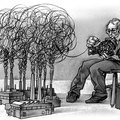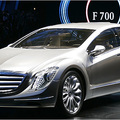JENA, Germany — For those seeking the elixir that has given new life to Germany’s economy, a visit to this ancient university town in the eastern part of the country would be a good place to start.
Jena is booming these days, as local companies like Jenoptik, which makes lasers and sensors, rack up orders from China, Russia, Europe and the United States. Even the surging euro, which is near record levels against the dollar and the yen — making German exports more expensive in many foreign markets — has not yet dented demand.
“There’s no better proof that our products are superior than to have an indirect price increase of 30 percent without losing any sales,” said Alexander von Witzleben, the self-confident chief of Jenoptik.
Germany’s transformation from Europe’s sick man to its most stalwart performer is by now well entrenched. So sanguine are German executives about their future that many brush aside fears that a slowdown in the United States could knock their export-led recovery off track.
The American consumer may still be the main engine that drives the global economy, but Germany’s advance — it has been the world’s largest exporter of goods for the last four years — is propelled by other sources. It is one more sign that the rest of the world does not depend as much on the American economy as it once did.
Mr. von Witzleben said that Germany now exports more to Russia and the former Soviet satellites than it does to the United States. It ships nearly as much to Britain as to America, and its total exports within Europe are five times its shipments to the United States.
“Germany is projecting itself into the global economy, using its historic strengths of good quality and strong brands,” said Nicolas Sobczak, senior European economist at Goldman Sachs in Paris. “The simple fact that the German labor market is turning, that you have genuine job creation, shows that this is a genuine German renaissance, one that is independent of the U.S.,” he continued.
The numbers tell the story. Unemployment is dropping rapidly — at 9.8 percent, it has fallen below double-digits for the first time since 2002 — while investor confidence is soaring. An increase in the value-added tax in January, which economists once warned would torpedo the recovery, caused scarcely a ripple.
Germany’s rise has set it apart from its European neighbors. While Italy struggles to regain its export momentum and France waits for a presidential election that could reshape its political and economic landscape, Germany has doggedly molded itself into a globally competitive player.
The therapy was often brutal: waves of layoffs and cost-cutting during the lean years from 2002 to 2005. But having fended off steep wage increases at home and moved some manufacturing to lower-cost markets abroad, many German companies are reaping profits.
The crucial factor in Germany’s success, Mr. von Witzleben of Jenoptik said, is that it churns out what he calls global niche products: sophisticated high-technology tools that have worldwide but narrow markets. Fast-growing developing economies, like China’s, are keener to buy such rarefied products than to make them.
Only Japan currently competes in many of these areas — and perhaps not coincidentally, the Japanese economy is also humming.
“We are protected because the big Asian gorillas are not interested,” Mr. von Witzleben said. “If I were in the business of flat-panel television screens, it would be a different story.”
Jenoptik, which was built on the ruins of an East German state enterprise, concentrates on making lasers used in medical devices and chip factories. It also builds sensors that steer satellites.
Of its $645 million in sales, 57 percent comes from exports. Its order book is running well ahead of last year, when it recorded a 7 percent gain over 2005. Germany has hundreds of medium-size companies like Jenoptik, and many of them are making similar inroads overseas. This success is proving difficult for other major European countries to replicate — for reasons of politics, economic policy or the structure of their industries.
“Germany is pretty much out of sync with the rest of Europe, which is muddling through,” Mr. Sobczak of Goldman Sachs said.
Europe, of course, benefits from a resurgent Germany simply because of its size. It accounts for a fifth of the economic activity of the European Union, and its trade within Europe is booming.
Last year, German exports to Poland rose 29 percent, while imports from Poland rose 23 percent. Such numbers have fueled the euro, which is trading at the highest levels against the dollar since March 2005.
All told, the German economy should grow about 2 percent this year, according to public and private projections. That is less than the 2.7 percent it grew last year, when the world economy was more robust. But it is more than respectable, economists say, given that the European Central Bank has raised interest rates seven times since late 2005.
There are, of course, caveats. Germany’s consumers, rattled by layoffs, have yet to reopen their wallets and purses. Unless they start spending, economists say, the recovery could peter out.
The euro’s relentless rise will eventually start to bite. And a sharp slowdown in the United States would reverberate here, regardless of Germany’s modest dependence on trans-Atlantic trade.
“If the U.S. consumer were to collapse because of the housing market, the Fed would cut rates and the dollar-euro rate would shoot up,” Mr. Sobczak said. “That could be a killer for Europe.”
Still, Germany may be more insulated from the United States than other major European countries, like France and Spain. Those economies are being lubricated mainly by domestic consumption, which hinges on the vibrant housing market in both countries.
A sharp decline in the American real estate market, economists say, would have an echo effect on France and Spain. In Germany, by contrast, housing prices are already depressed.
Germany’s renaissance is challenging other preconceptions about this economy — Europe’s largest and the third biggest in the world, behind the United States and Japan. While previous economic upturns have bypassed the depressed eastern part of the country, there is evidence that in pockets, at least, eastern Germany is also catching the favorable winds of trade and export.
In Jena, for example, the unemployment rate declined to 11.1 percent in 2006, from 16.3 percent in 1998.
In a recent ranking of the most competitive and economically promising regions of Germany, 3 of the top 20 cities are in the east: Dresden, Potsdam and Jena. The most competitive city is a longtime winner, Munich, according to the study by a Swiss consulting firm, Prognos.
Eastern Germany’s three southernmost states — Saxony, Thuringia and Saxony-Anhalt — are growing faster than Germany as a whole, while the northern states in the east are languishing.
As it regains its edge nationally, analysts say, Germany is becoming marked by ever sharper disparities between vibrant and struggling regions. While Jena’s population is growing, rural regions not far from the city continue to lose people, particularly young women, to the West.
In Jena, which was settled in the ninth century and was the site of one of Napoleon’s famous battles in 1806, few people have the time to fret about troubles elsewhere. With two universities, a clutch of scientific research institutes and a park for high-tech start-ups, Jena bustles like a transplanted Silicon Valley.
“It’s better to have successful cities, which can then reflect their success on to the rural areas,” said Albrecht Schröter, a Protestant minister who is the mayor of Jena.
For Mr. von Witzleben, these differences are not only inevitable but commercially advantageous. Salaries for engineers, he said, are 35 percent lower here than in Baden-Württemberg, where the main city, Stuttgart, is the prosperous home of DaimlerChrysler.
“This is our big chance,” said Mr. von Witzleben, 43, who speaks in rapid and idiomatic English.
While Jenoptik has a union, it is not subject to the kind of industrywide contracts that cover workers at big companies like DaimlerChrysler. That gives it the flexibility, for example, to ask for overtime without making costly payments. Employees take part in a profit-sharing plan.
Jenoptik has kept the vast majority of its production in Germany. While Mr. von Witzleben has contemplated opening a factory in China, he concluded it would not generate enough savings to justify the investment.
Jena was the home of Carl Zeiss, the celebrated optical firm that moved its headquarters to West Germany after World War II. With its roots in the old Zeiss, Jenoptik has a tradition of precision engineering and technology that allows it to compete in elite fields.
The company, for example, makes “star sensors” that navigate satellites in orbit. Boeing has installed Jenoptik sensors in its satellites that beam television signals to American homes.
“If I told you 15 years ago that this former Communist combine would become a preferred supplier to Boeing,” Mr. von Witzleben said, “you would have told me to stop drinking wine.”




